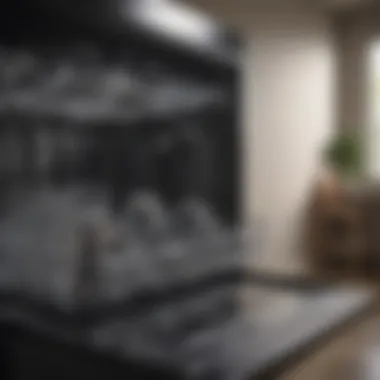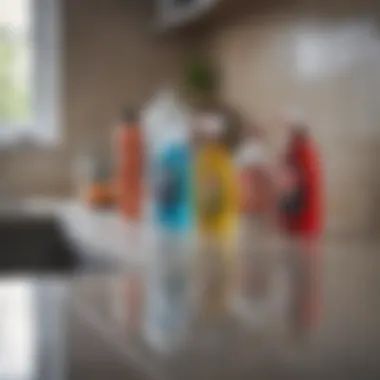Effective Strategies to Remove Grime from Your Dishwasher


Intro
Maintaining a clean dishwasher is essential for both appliance efficiency and kitchen hygiene. Grime can accumulate in various forms, including food particles, soap scum, and mineral deposits. Understanding how to effectively clean this appliance can save time and enhance its longevity. This guide will explore step-by-step methods for removing grime, focusing on natural and commercial cleaning options. It aims to equip readers with practical knowledge to prevent grime buildup, ensuring optimal dishwasher performance.
Common Sources of Grime
Before delving into cleaning methods, it is important to recognize where grime typically originates. Common sources include:
- Food residues: Small bits of food can become trapped in the dishwasher, leading to bacteria growth.
- Soap scum: Detergents may leave behind residue, particularly if excessive soap is used.
- Hard water: Mineral buildup from hard water can create a stubborn crust.
Identifying these sources allows for better targeted cleaning efforts.
Cleaning Techniques
Natural Cleaning Methods
Natural cleaning methods are an eco-friendly option for keeping your dishwasher grime-free. Useful ingredients include:
- White vinegar: It effectively removes grease and deodorizes the appliance. Pour one cup of vinegar in the bottom of an empty dishwasher and run a hot-water cycle.
- Baking soda: This can tackle stains and odors. After running the vinegar cycle, sprinkle a cup of baking soda across the bottom and run a short cycle. This can freshen the interior and help with stubborn stains.
Commercial Cleaning Products
For those who prefer commercial solutions, various products are available. Here are a few notable ones:
- Affresh Dishwasher Cleaner: This product helps eliminate limescale and mineral deposits.
- Finish Dishwasher Cleaner: Designed to clean hidden parts of the machine, it effectively removes grease and grime.
When using commercial products, always follow the manufacturer's instructions for best results.
Prevention Strategies
To maintain a clean dishwasher, consider the following prevention strategies:
- Regular cleaning: Implement a routine cleaning schedule, ideally once a month.
- Proper loading: Make sure dishes are loaded correctly to avoid trapping food particles.
- Use appropriate detergents: Choose a good quality detergent that fits your water type.
By incorporating these habits, you can significantly reduce the frequency of deep cleaning required.
"An ounce of prevention is worth a pound of cure."
Closure
Keeping your dishwasher free of grime not only enhances its performance but also promotes a healthier kitchen environment. Through understanding the sources of grime and applying effective natural and commercial cleaning methods, individuals can prolong the life of their appliances. Regular maintenance paired with preventive strategies offers a practical approach to achieve a spotless dishwasher.
Understanding Grime Buildup
Understanding grime buildup is a crucial part of maintaining the efficiency and longevity of your dishwasher. Grime refers to the collection of dirt, grease, and food particles that accumulate over time. Not only does this buildup affect the overall performance of the dishwasher, but it can also become a breeding ground for bacteria, which can lead to unpleasant odors and ineffective cleaning results.
What Constitutes Grime
Grime includes various elements that can compromise the functionality of your dishwasher. It consists mainly of:
- Food Residues: Leftover food can stick to the filter, spray arms, and walls, blocking water flow.
- Grease: Oils from food can create sticky surfaces that trap additional dirt.
- Mineral Deposits: Hard water can leave limescale buildup which garners grime more easily.
- Soap Scum: Detergents can also lead to build-up, particularly in areas with hard water.
Understanding these components helps in identifying the root causes of the problem and informs your cleaning strategy.
Common Sources of Grime in Dishwashers
Grime in dishwashers typically comes from several predictable sources. Noticing these can assist in strategies to prevent buildup from occurring in the first place:


- Poor Loading Practices: Overloading your dishwasher may prevent proper cleaning, leading to unwashed food particles being left behind.
- Infrequent Use: A seldom-used dishwasher can develop odors and dirt as moisture allows bacteria to thrive.
- Food Waste Size: Large pieces of food waste that bypass the filter can accumulate in crevices within the dishwasher.
- Using Low-Quality Detergent: Cheaper detergents may not dissolve properly, leading to residue accumulation.
- Hard Water: Living in an area with hard water makes your dishwasher more prone to mineral deposits, hindering performance.
Recognizing these sources is helpful as it can inform both cleaning efforts and everyday usage habits to minimize grime buildup.
"Understanding the components and sources of grime is essential for maintaining a dishwasher's efficiency and hygiene."
Identifying Signs of a Dirty Dishwasher
Understanding the signs of a dirty dishwasher is essential for maintaining its efficiency and functionality. Regular maintenance can help extend the lifespan of the appliance. However, the first step in effective cleaning is recognizing the indicators that trouble lurks below the surface. By identifying these signs early, you ensure that your dishwasher remains in optimal condition, providing clean dishes and preventing potential health hazards from bacterial growth.
Unpleasant Odors
One of the most noticeable signs that your dishwasher is dirty is unpleasant odors emanating from it. These odors often arise from food particles that have become trapped in various parts of the machine. The buildup of bacteria and mildew can turn what should be a clean appliance into a source of foul smells.
To combat this issue, pay attention to any persistent smells that linger, especially after a cycle is complete. If you notice an acrid or musty scent, it is crucial to take action. These odors not only signal the need for cleaning but can also affect the freshness of your dishes after washing. Promptly addressing bad smells is important, as it directly relates to the hygiene of your kitchen.
Standing Water
Another clear sign of a dirty dishwasher is the presence of standing water at the bottom after a wash cycle. This can indicate a problem with drainage or a clog in the filter. Water accumulation can create an environment conducive to bacterial growth. It can also affect the cleanliness of your dishes. Effective dishwashing relies on proper drainage; without it, grime and residue can build up over time.
If you encounter this issue, investigate the drain filter and ensure it is free of blockages. If the problem persists, it may require further examination of the plumbing associated with the dishwasher. Leaving standing water unchecked can lead to much larger problems down the line.
Residue on Dishes
The final sign to watch for is the appearance of residue on your dishes after they have been washed. If dishes are coming out of the dishwasher with spots, streaks, or leftover food particles, it suggests that the appliance is not performing optimally. It indicates that the spray arms may be clogged or that there is a lack of sufficient detergent and rinse aid to clean properly.
This issue can result not only in poor hygiene for your kitchenware but also in the necessity of hand washing. Consumers expect their dishwashers to perform reliably. When dishes do not come out clean, it can cause frustration and concern regarding the overall healthiness of the kitchen environment.
"Identifying these signs early can prevent future complications and enhance the longevity of your appliance."
Preparation for Cleaning
Preparing to clean your dishwasher is a crucial step that should never be overlooked. This phase sets the stage for effective cleaning and ensures you have everything required to tackle grime and maintain the appliance’s functionality. A thorough preparation will save time and effort during the actual cleaning process and can improve the overall results.
Gathering Necessary Supplies
Gathering the right supplies is essential for effective cleaning. Here are some items you might need:
- Dishwasher cleaner: This can be a commercial product designed for specific cleaning needs.
- White vinegar: A natural cleaner that helps eliminate odors and break down mineral deposits.
- Baking soda: Perfect for tackling stains and neutralizing smells.
- Citric acid: Useful for limescale removal.
- Soft cloths or sponges: For wiping down surfaces.
- A small brush: This can help clean tight spaces and the filter.
Having these items ready will make the cleaning process smoother and more efficient.
Safety Precautions
When cleaning your dishwasher, taking safety precautions is vital. It ensures your safety and the integrity of your appliance. Consider the following:
- Unplug the Dishwasher: Disconnect the power supply to prevent electric shock.
- Use gloves: Protect your hands from harsh chemicals, especially if using commercial cleaning products.
- Ensure Ventilation: Make sure there is good airflow in the kitchen. This is especially important if you are using strong cleaners.
- Read Labels: Always examine the labels on cleaning products to understand the correct usage and safety information.
These precautions can help prevent accidents and health issues, allowing you to focus on achieving a clean and well-maintained dishwasher.
Step-by-Step Cleaning Process
Cleaning your dishwasher properly is essential for maintaining its efficiency and longevity. A thorough cleaning eliminates grime buildup, prevents odors, and ensures that your dishes come out clean and sanitized. The step-by-step approach helps you address each part of the dishwasher systematically. This organization ensures you do not overlook any section, contributing to the overall effectiveness of the cleaning process.
Removing and Cleaning the Filter
The filter often traps food particles and other debris. Cleaning it is crucial to maintain water circulation and quality.* First, locate the filter, which is typically at the bottom of the dishwasher. Turn it counterclockwise and lift it out carefully. Rinse the filter under running water and use a brush to scrub away stubborn residue. Ensure to replace the filter securely once cleaned. This step plays a significant role in enhancing the dishwasher's efficiency.*
Cleaning the Interior


The interior can accumulate stains and odors over time. Start by removing any loose items, such as utensils or dishes from the dishwasher. Next, wipe the walls, bottom, and door with a damp cloth. For tough stains, a mild detergent can be used. Focus on areas like the tub and door edges, where grime tends to gather. Rinsing thoroughly after cleaning ensures no residue is left behind.* This keeps the dishwasher hygienic and ready for use.*
Cleaning the Spray Arms
The spray arms distribute water throughout the dishwasher. If they become clogged, it can lead to uneven washing. To clean them, remove the arms by unscrewing or pulling them off, depending on the model. Inspect the holes for blockages, using a toothpick or needle to clear them if necessary. Rinse the spray arms under water before reattaching them. This simple task can greatly improve washing effectiveness.*
Tackling the Door Seals
The door seals are often overlooked but are essential for preventing leaks. Inspect the seals for debris and clean them gently using a damp cloth. It's important to avoid using any harsh chemicals, as these can damage the material. Keeping the seals clean helps ensure a tight closure, which is vital for optimal performance and efficiency of your appliance.*
Wiping Down the Exterior
Finally, don't forget the exterior of the dishwasher. Use a suitable cleaner and a microfiber cloth to wipe down surfaces. This not only improves the appearance of the appliance but also prevents the buildup of grease and grime, contributing to a more hygienic kitchen environment. Remember, a clean exterior reflects proper maintenance and care.*
Keeping your dishwasher clean is not just about aesthetics; it directly impacts its performance and lifespan.
Natural Cleaning Solutions
Natural cleaning solutions play a crucial role in maintaining the hygiene of your dishwasher without exposing it to harsh chemicals. These solutions can effectively eliminate grime, odors, and residues while being environmentally friendly. By utilizing common household ingredients, you not only save money but also reduce chemical exposure for your family and the environment.
Choosing natural methods for cleaning enables you to optimize your dishwasher's performance. Unlike commercial cleaners that may contain additives, natural solutions are less likely to leave behind harmful residues. This approach is especially beneficial for households prioritizing health and sustainability.
Vinegar for Odor Elimination
Vinegar is a powerful natural deodorizer. Its acetic acid content helps neutralize unpleasant smells that can linger in your dishwasher. To utilize vinegar effectively, pour two cups of white vinegar into a dishwasher-safe bowl and place it on the top rack of an empty dishwasher. Run a hot cycle to allow the vinegar to circulate throughout the appliance.
The process removes odors while also cutting through grease and grime. Regular use of vinegar not only combats smells but also impedes the growth of bacteria, ensuring a more sanitary environment for clean dishes.
Baking Soda for Stain Removal
Baking soda stands out as a versatile cleaning agent. It functions as a mild abrasive that can help lift stains and residues found on the interior of your dishwasher. For optimal use, scatter a cup of baking soda evenly over the bottom of an empty dishwasher and run a short hot cycle.
This method effectively targets stains, boosting the brightness of the interior surfaces. Additionally, baking soda complements vinegar's deodorizing effects, leading to a dual-action cleaning process that prevents grime from building up in the future.
Citric Acid for Limescale
Citric acid is particularly effective against limescale that can accumulate over time. This acid, often found in citrus fruits, is effective in dissolving mineral deposits. To use citric acid for cleaning, simply add a cup of citric acid powder directly to the bottom of your dishwasher. Run a hot cycle without dishes to allow the citric acid to target and break down the limescale.
This cleaning method can restore the dishwasher's efficiency, improving the quality of water used during cycles. Regular treatment with citric acid helps in preventing limescale buildup, ensuring a longer-lasting appliance.
Key Takeaway: Implementing natural cleaning solutions, such as vinegar, baking soda, and citric acid, can enhance dishwasher performance while fostering a safe and eco-friendly cleaning routine.
Commercial Cleaning Products
In the quest for a grime-free dishwasher, commercial cleaning products serve as powerful allies. These products are specifically formulated to target and remove the tough residues that accumulate over time, enhancing both the performance and longevity of the appliance. When selecting a cleaning product for your dishwasher, it is essential to consider effectiveness, safety, and the specific requirements of your appliance.
Evaluating Product Options
Choosing the right cleaning product involves several considerations:
- Ingredients: Check for harsh chemicals that could damage the dishwasher or leave harmful residues. Opt for products with biodegradable components.
- User Reviews: Assess feedback from others who have used the product. Ratings can highlight successes and potential issues.
- Versatility: Some cleaners can be used for other kitchen appliances as well, making them more economical.
- Brand Reputation: Established brands often have proven results. Researching a brand’s history can offer insights into their reliability.
Before purchasing, look for options that provide a detailed description of their cleaning capabilities. This ensures that the chosen product aligns with the specific grime issues faced.
Application of Commercial Cleaners
The application process is straightforward if followed correctly:
- Read the Instructions: Each product may have specific application methods, emphasizing the need to follow manufacturer guidelines.
- Ensure Safety: Before starting, open windows for ventilation and wear gloves if necessary.
- Pre-Clean: Remove any larger food particles from the dishwasher to enhance the effectiveness of the cleaner.
- Application: Pour the recommended amount of cleaner into the designated compartment or directly inside the dishwasher as instructed.
- Run a Cycle: Set the dishwasher to the hottest and longest cycle. This helps in thoroughly breaking down the grime.
- Wipe Down: Once the cycle is completed, wipe down the interior surfaces with a soft cloth to remove any remaining cleaner or dissolved grime.


"Using commercial cleaners appropriately can make a significant difference in maintaining the efficiency and hygiene of your dishwasher."
By adhering to these steps, one can effectively utilize commercial cleaners to achieve a cleaner and better-performing dishwasher.
Maintenance for a Clean Dishwasher
The importance of maintenance cannot be overstated when it comes to prolonging the life and efficiency of your dishwasher. By implementing a systematic approach to upkeep, one can prevent the buildup of grime, which can lead to reduced performance and even mechanical failure. Regular maintenance ensures that the appliance functions at its best, providing clean dishes and saving water and energy in return.
Establishing a routine maintenance schedule not only minimizes future problems but also maximizes the appliance's operational lifespan. Harmful residues can accumulate in the filter and spray arms if overlooked for too long. This accumulation can hinder performance, causing both dirty dishes and unpleasant odors. Moreover, a well-maintained dishwasher is less likely to harbor mold and bacteria, contributing to a healthier kitchen environment.
Regular Cleaning Schedule
Creating a consistent cleaning schedule helps maintain the dishwasher's cleanliness and effectiveness. A simple routine can involve checking and cleaning the filter weekly, wiping down the door seals every month, and giving the interior a deep clean every three months. This approach can keep grime at bay and minimize any unpleasant odors.
Utilizing the Dishwasher Properly
Using the dishwasher correctly is equally essential for its maintenance. Ensure you are loading dishes appropriately, avoiding overcrowding, and using the right cycle for different types of loads. This not only maximizes cleaning efficiency but also protects the appliance from unnecessary wear. Always remember to rinse large food particles from dishes before placing them inside. This prevents clogs from forming, which can be a source of grime accumulation over time.
In summary, establishing a cleaning schedule and practicing proper loading techniques will greatly enhance the lifespan and performance of your dishwasher.
When to Call a Professional
Cleaning a dishwasher can be straightforward when addressing common issues like grime buildup. However, there are instances where professional intervention is necessary. Recognizing these situations can save you time, effort, and potential damage to your appliance.
Recognizing Persistent Issues
Certain problems, if recurring despite your cleaning efforts, signal a need for professional help. For instance, if unpleasant odors, residual food particles, or standing water persist even after thorough cleaning, the cause may be more profound. Potential blockages in the plumbing, damage to the internal components, or malfunctioning parts could be at fault.
If you notice that the dishwasher fails to clean dishes effectively even after cleaning the spray arms and filter, this may indicate a malfunction in the motor or pump.
In such cases, these signs may suggest:
- Clogs that require specialized tools: Professionals have equipment that can reach deep into the appliance.
- Electrical issues: If the dishwasher is not powering on or shows erratic functions.
- Parts replacement: Professionals can assess and replace broken components efficiently.
Addressing these issues early can prevent further damage to the dishwasher, ultimately saving you from more expensive repairs down the line.
Understanding Warranty Considerations
Warranties can significantly influence whether you choose to call a professional or attempt to fix the dishwasher yourself. Most dishwasher brands offer warranties that cover manufacturing defects but come with specific terms and conditions.
If your dishwasher is still under warranty, any repairs should ideally be performed by authorized service personnel to avoid voiding the warranty. Attempting repairs without professional help, especially if the appliance can be repaired under warranty, might not only lead to further complication but may also result in unforeseen expenses.
It is advisable to review your warranty documents, as they often contain details regarding:
- Coverage periods: Knowing how long your warranty is valid can help in decision making.
- Authorized service contacts: Many manufacturers provide a list of accredited technicians.
- Conditions on repairs: Understanding which types of issues are covered can steer your maintenance approach.
"Knowing when to call a professional can protect your investment and maintain the efficiency of your dishwasher."
End
Cleaning grime from your dishwasher is more than an aesthetic task. It has significant implications for the appliance's performance and longevity. Maintaining cleanliness ensures that your dishes come out spotless and free from contaminants, which is essential for both hygiene and food safety. A clean dishwasher can save you time and energy in the long run, reducing the need for repeated cycles due to residue buildup.
Recap of Cleaning Methods
Throughout this article, various cleaning methods have been detailed. These include:
- Natural Solutions: Vinegar, baking soda, and citric acid are effective in tackling different types of grime. Vinegar neutralizes odors, baking soda removes stains, and citric acid targets limescale build-up.
- Commercial Cleaners: Specific products can enhance cleaning effectiveness when used correctly. These should be applied following manufacturer instructions to avoid any risk to your dishwasher.
- Step-by-Step Process: From removing the filter to wiping down the exterior, a systematic approach reduces the chances of overlooking grime.
Each method emphasizes the importance of regular maintenance. Incorporating these cleaning techniques ensures your dishwasher operates efficiently.
Final Thoughts on Maintenance
Regular maintenance is crucial for keeping your dishwasher in optimal condition. Establishing a cleaning schedule can prevent grime build-up before it becomes a significant issue. Consider using natural cleaning solutions periodically, and ensure to follow the proper loading and usage instructions to minimize the risk of grime accumulation.
In summary, clean dishwashers function better and last longer. With these strategies in mind, you can enhance your kitchen hygiene and appliance performance. Keeping your dishwasher clean is an investment in both your health and your kitchen efficiency.







